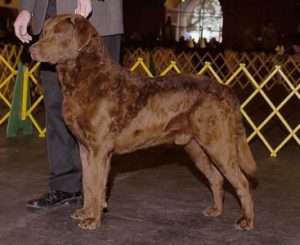
The Chesapeake Bay Retriever is a breed of dog belonging to the Retriever, Gundog, and Sporting breed groups. Members of the breed may also be referred to as a Chessie, CBR, or Chesapeake. The breed was developed in the United States’ Chesapeake Bay area during the 1800s. Historically used by area market hunters to retrieve waterfowl, it is primarily a family pet and hunting companion. It is a medium to large sized dog, similar in appearance to the Labrador Retriever. They are aptly described as having a bright and happy disposition, courage, willingness to work, alertness, intelligence, and love of water as some of their characteristics.
Appearance
Distinctive features include eyes that are very clear, of yellowish or amber hue, hindquarters as high or a trifle higher than the shoulders, and a double coat that tends to wave on shoulders, neck, back, and loins. The waterproof coat feels slightly oily and is often associated with a slight musky odour. Three basic colours are generally seen in the breed: brown, which includes all shades from a light to a deep dark brown; sedge, which varies from a reddish yellow through a bright red to chestnut shades; and deadgrass in all its shades, varying from a faded tan to a dull straw colour. The breed standard states that white may also appear but it must be limited to the breast, belly, toes, or back of the feet. The head is round and broad with a medium stop and muzzle. The lips are thin, and the ears are small and of medium leather. The forelegs should be straight with good bone. The hindquarters are especially strong and the toes webbed since excellent swimming ability is important for the Chesapeake. This breed is also known for their large and powerful chests; used to break apart ice when diving into cold water while duck hunting.
Coat
The coat of the Chesapeake Bay Retriever is given the most consideration of any trait when judging conformation. The hair on the face and legs should be very short and straight with a tendency to wave, never curl, on the shoulders, neck, back, and loins only and nowhere over 1.5 in long. Moderate feathering on the rear of hindquarters and tail is permissible although not longer than 1.75 inches long. The texture of the thick double coat is important in protecting the dog from cold water and icy conditions, The oil in the harsh outer coat and woolly undercoat resists water, keeping the dog dry and warm. Maintenance of the coat is minimal and mainly consists of brushing with a short-tooth brush once a week. It is difficult to get a Chesapeake Bay Retriever thoroughly wet, but they should be bathed every 3–4 months using a suitably mild shampoo, then dried thoroughly. Brushing or bathing more often can ruin the texture since it strips the protective oil from the coat, and may even remove the undercoat.. The colour of the coat must be similar to the working surroundings. Any colour of brown, sedge or deadgrass is acceptable and one colour is not preferred over another. The American Chesapeake Club includes a discussion on colour.
Three basic colours are generally seen in the breed: Brown which includes all shades from a light cocoa (a silvered brown) to a deep bittersweet chocolate colour; sedge which varies from a reddish yellow through a bright red to chestnut shades; deadgrass which takes in all shades of deadgrass, varying from a faded tan to a dull straw colour. Historic records show that some of the deadgrass shades can be very light, almost white in appearance, while darker deadgrass colours can include diluted shades of brown called ash, that appear as either grey or taupe. The almost white and ash/taupe/grey shades are not commonly seen, but are acceptable.
The difference between a sedge and a deadgrass is that the deadgrass shades contain no significant amount of red, while the sedge shades do have red. Coat and texture also play a factor in the perception of colour. The self-colour pattern is preferred by the standard (One colour with or without lighter and darker shadings of the same colour). You will see dogs with varying degrees of other markings such as: masking on top of the skull, striping effect of light & dark through the body and on legs, distinct & indistinct saddle markings, agouti colouring and tan points. All are acceptable, they are just not preferred.
A white spot on the breast (not extending above the sternum), belly, toes or back of the feet is permissible, but the smaller the spot the better. White beyond these areas and black anywhere on the body is not allowed in the breed standard.
Temperament
The Chesapeake Bay Retriever is valued for its bright and happy disposition, intelligence, quiet good sense, and affectionate protective nature. Some of them can be quite vocal when happy, and some will ‘smile’ by baring their front teeth in a peculiar grin – this is not a threat but a sign of joy or submissiveness.
Temperament can be an inherited trait. Selecting a puppy from parents with good temperaments is advised.
Like other dogs, Chesapeake Bay Retrievers can make excellent family dogs when socialised properly. Chesapeakes can be more assertive and wilful and may be reserved with strangers while others are passive and outgoing with people. It simply depends on the personality of the dog.
—————————————————————————————————————–
CARING FOR YOUR DOG NEWSLETTER – Delivered Directly To Your Inbox – Starting Immediately – SIGN UP FOR FREE TODAY
—————————————————————————————————————–
